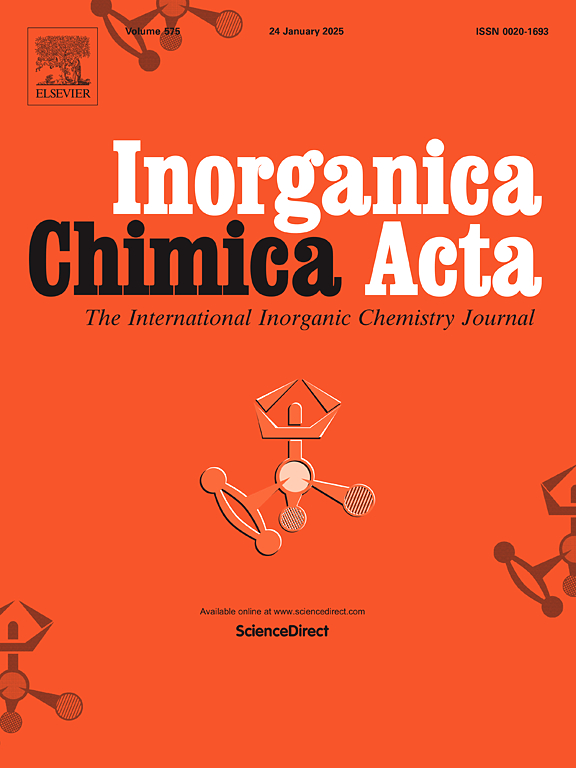Synthesis, structural characterization and DFT study of a cobalt(III)/cobalt(II) complex derived from N,O donor reduced Schiff base ligand
IF 2.7
3区 化学
Q2 CHEMISTRY, INORGANIC & NUCLEAR
引用次数: 0
Abstract
The present work descries the strategic design and synthesis of a dinuclear mixed-valence Co(III)/Co(II) complex, [(N3)CoIIILr(μ-O2CR1)CoII(N3)]·CH3OH, which has been synthesized using an N2O4 donor compartmental ligand, H2Lr {(2,2-dimethyl-1,3-propanediyl)bis(iminomethylene)bis(6-ethoxyphenol)}, CoCl2·6H2O, benzoic acid (R1CO2H) and NaN3 in 1: 2: 1: 2 ratio. Single crystal X-ray diffraction structure confirms the presence of a Co2O2 core in the complex. Co(III) center is present in the inner N2O2 donor pocket and cobalt(II) center is trapped in the outer O2O′2 donor pocket, as confirmed by bond length consideration and BVS calculation. Experimental effective magnetic moment supports the presence of three unpaired electron in the complex. DFT calculation is performed to confirm th oxidation state of The high spin configuration is 28.2 kcal/mol more stable than the low spin configuration at the CAM-B3LYP/Lanl2DZ/6-31G(d) level of theory, thus supporting the quadruplet nature of the complex.

N,O给体还原希夫碱配体衍生钴(III)/钴(II)配合物的合成、结构表征及DFT研究
本工作描述了双核混合价Co(III)/Co(II)配合物[(N3)CoIIILr(μ-O2CR1)CoII(N3)]·CH3OH的策略设计和合成,该配合物是用N2O4供体区室配体H2Lr{(2,2-二甲基-1,3-丙二基)二亚胺基二(6-乙氧基酚)}、CoCl2·6H2O、苯甲酸(R1CO2H)和NaN3以1:2:1:2的比例合成的。单晶x射线衍射结构证实了配合物中Co2O2核心的存在。通过键长和BVS计算,Co(III)中心位于N2O2给体口袋内侧,而钴(II)中心位于O2O ' 2给体口袋外侧。实验有效磁矩支持络合物中存在三个未配对电子。通过DFT计算,在CAM-B3LYP/Lanl2DZ/6-31G(d)理论水平上证实了高自旋构型的氧化态比低自旋构型的氧化态稳定28.2 kcal/mol,从而支持了配合物的四重态性质。
本文章由计算机程序翻译,如有差异,请以英文原文为准。
求助全文
约1分钟内获得全文
求助全文
来源期刊

Inorganica Chimica Acta
化学-无机化学与核化学
CiteScore
6.00
自引率
3.60%
发文量
440
审稿时长
35 days
期刊介绍:
Inorganica Chimica Acta is an established international forum for all aspects of advanced Inorganic Chemistry. Original papers of high scientific level and interest are published in the form of Articles and Reviews.
Topics covered include:
• chemistry of the main group elements and the d- and f-block metals, including the synthesis, characterization and reactivity of coordination, organometallic, biomimetic, supramolecular coordination compounds, including associated computational studies;
• synthesis, physico-chemical properties, applications of molecule-based nano-scaled clusters and nanomaterials designed using the principles of coordination chemistry, as well as coordination polymers (CPs), metal-organic frameworks (MOFs), metal-organic polyhedra (MPOs);
• reaction mechanisms and physico-chemical investigations computational studies of metalloenzymes and their models;
• applications of inorganic compounds, metallodrugs and molecule-based materials.
Papers composed primarily of structural reports will typically not be considered for publication.
 求助内容:
求助内容: 应助结果提醒方式:
应助结果提醒方式:


